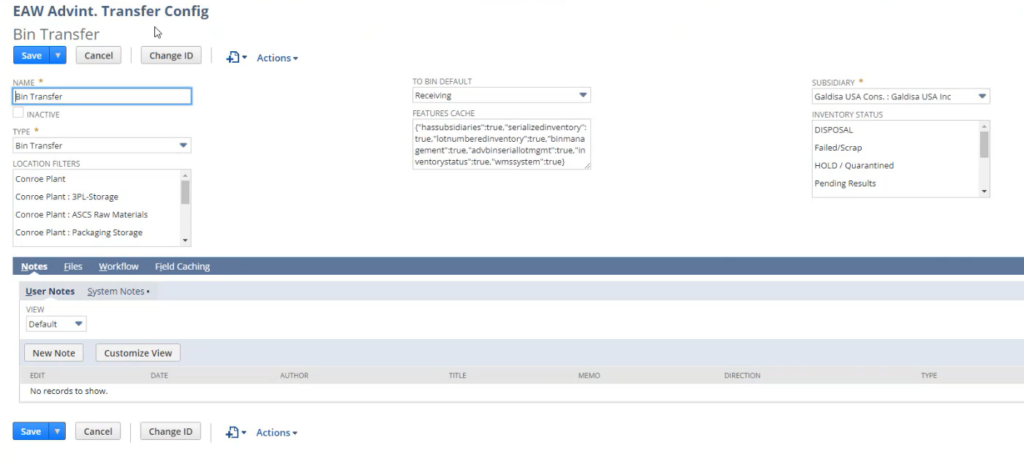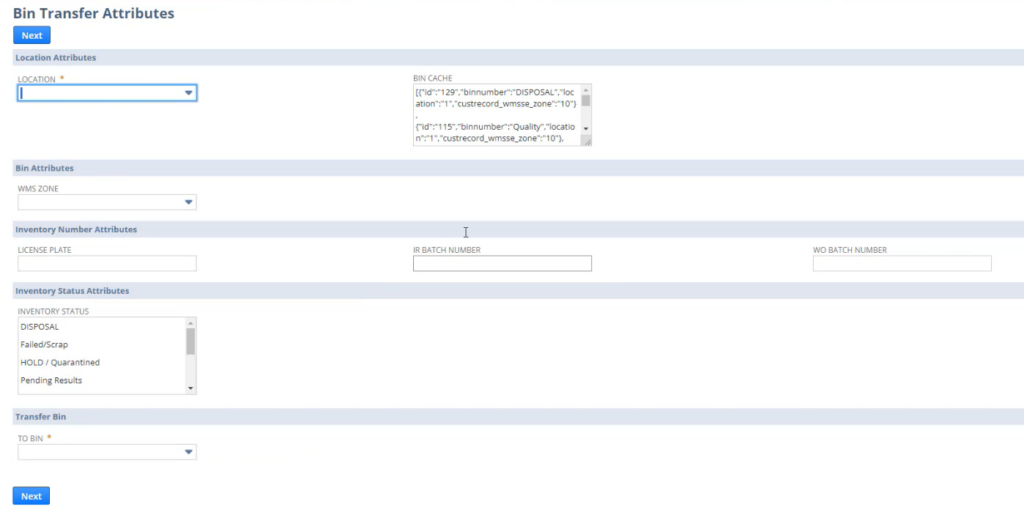Introduction
The Simple Inventory Transfer process in NetSuite offers a straightforward method for users to relocate inventory between bins. Designed for ease of use, this process involves exporting data through a saved search, applying filters to select specific bins, and specifying the destination bin. It is ideal for routine transfers that do not require the advanced configurations and dynamic filtering capabilities of the more complex transfer processes.
1. Simple Inventory Transfer
Accessing the Simple Inventory Transfer
- First, navigate to Setup > Import/Export > Bin Transfer Import.
Steps for Simple Inventory Transfer
- Export Data:
- Use the link provided to access a saved search.
- This search outputs all available bins.

- Apply Filters:
- Next, in the saved search, apply filters to locate specific bins as required.

- Specify Destination:
- Define the “To Bin” to designate where the inventory should be moved.
- Validation:
- The import process will automatically fail if an incorrect bin is specified.
Points to Note
- Ensure correct bins are selected to avoid failed transfers.
- Filters aid in efficient and accurate bin selection.
Cons of Simple Inventory Transfer
The Simple Inventory Transfer in NetSuite, while user-friendly and straightforward for basic inventory moves, comes with certain limitations that can impede more complex operations. One notable drawback is the inflexibility of the saved search import function; specific columns are immutable, and any attempt to alter them can result in the import failing, leading to inefficiencies and potential for error. Furthermore, because the saved search operates independently of the transfer process, NetSuite lacks the ability to directly capture and respond to the user’s filtering choices. This disconnect means users must manually import the filtered data back into NetSuite to execute the transfer, a step that can be both time-consuming and prone to data entry errors, making the Simple Inventory Transfer less suited for nuanced or elaborate inventory management tasks.
Conclusion
The Simple Inventory Transfer is an essential function within NetSuite that facilitates quick and direct inventory movements. By adhering to the steps outlined in this documentation and ensuring accurate selection of bins and destination points, users can efficiently manage their inventory transfers, maintain inventory accuracy, and optimize their warehouse operations.
2. Advanced Inventory Transfer
Introduction
In contrast, the Advanced Inventory Transfer process represents a sophisticated approach to managing inventory within NetSuite. It eliminates the need for exporting and importing via saved searches by employing dynamic filters that interact with a configurable record. This process caters to more complex inventory management requirements, allowing users to filter by subsidiary, location, “To Bin,” and inventory status. It also adapts to the specific features of the user’s NetSuite account, such as serial and lot number tracking, and bin management, providing a tailored and flexible inventory transfer experience.
Accessing the Advanced Inventory Transfer
First, navigate to Transactions > Adv. Inventory Transfers > Bin Transfer to begin the process.
Setting Up Configurations
Access Configuration Record
On the EAW Advanced Inventory Transfer Configuration record, define transfer settings.

Configuration Details
- Name and Type: Assign a name and select ‘Bin Transfer’ as the type.
- Location Filters: Select from predefined locations for the transfer origin.
- To Bin Default: Choose a default destination bin.
- Features Cache: Auto-detected features are listed, reflecting account capabilities.
- Subsidiary: Select the applicable subsidiary.
- Inventory Status: Choose the inventory status from options like DISPOSAL, HOLD, etc.
- Save Configuration: Save the settings with the ‘Save’ button.
- Feature-Based Display:
- The system dynamically checks for features like serial number, lot number, and bin management in the user’s account.
- Fields are displayed or hidden based on the available features.
Performing an Advanced Inventory Transfer

Define Transfer Attributes on Bin Transfer Attributes Page
- Location Attributes: Select the current item location.
- Bin Attributes: Specify the warehouse management zone.
- Inventory Number Attributes: Input applicable batch numbers.
- Inventory Status Attributes: Set the current inventory status.
- Transfer Bin: Choose the destination bin.
- Review and Save: Confirm attribute accuracy and proceed.
Reviewing Data Prior to Transfer
Access Review Data Page
Then, after setting attributes, verify transfer details on the Review Data page.
Verify Transfer Details
- Line Item Review: Ensure all line item details are correct.
- Data Verification: Match inventory numbers and quantities with physical inventory.
- Data Consistency: Check consistency with configuration settings.
- Error Correction: Use ‘Back’ to correct any discrepancies.
- Final Check: Perform a last review before submission.
Finalizing the Transfer
Submit Transfer
- Initiate Transfer: Click ‘Next’ after the final review to submit the transfer for processing.

Dry Run: After entering the filter criteria and reviewing the output data, click ‘Next’ for a dry run. This step is crucial to ensure the accuracy of the filtered data before the final transfer.
Final Submission: Following the dry run, review the data once more and click ‘Next’ to submit the transfer data for processing.
Benefits of Advanced Inventory Transfer
In contrast, the Advanced Inventory Transfer solution in NetSuite offers a robust and integrated approach to managing complex inventory needs. This sophisticated system bypasses the need for separate data imports by utilizing dynamic, in-app filters that automatically display the relevant data based on user input. It offers a seamless transition from filtering to transfer, significantly reducing the risk of data inconsistencies and import errors. Additionally, the Advanced Inventory Transfer adapts to the specific features of the user’s account settings, such as bin management, lot, and serial number tracking, providing a customized and comprehensive transfer experience. This level of integration and adaptability not only enhances accuracy but also empowers users to perform more nuanced inventory management tasks with ease, making it an ideal solution for businesses looking to optimize their inventory processes.
Points to Note
- Result Limitation for Submission: Users must ensure that the filtered results are fewer than 300 records. If the results exceed this number, the submission button will not be displayed, and the transfer cannot be initiated. This limit is in place to ensure system performance and data accuracy.
- Configuration Record Dependency: The transfer process relies on the Custom Record: EAW Advint. Transfer Config List. Users need to ensure that this configuration record is correctly set up before initiating the transfer to ensure the filtering works as intended.
- Account Features Integration: The Advanced Inventory Transfer solution dynamically interacts with the account’s enabled features, such as bin management and lot/serial numbers. The system will automatically display or hide fields based on these features.
- Filtering and Data Output: Unlike the simple inventory transfer, the advanced system directly uses the user’s input to filter and output data, streamlining the process and ensuring that only relevant data is reviewed and submitted.
- No Separate Data Import Required: The advanced process eliminates the need for a separate data import step, reducing the time and potential errors associated with manual data handling.
- Dry Run Functionality: Users are encouraged to utilize the dry run feature to validate the data before the final submission, which can help identify and rectify potential issues early in the process.
- User Interface Adaptability: The interface will adapt based on the user’s filtering choices, providing a more intuitive and responsive experience.
- Real-Time Data Reflection: As users apply filters, the system reflects changes in real-time, ensuring that the transfer is based on the most current and accurate inventory data.
- Comprehensive Review Step: A detailed review step is integral to the process, allowing for a thorough verification of all the transfer details on the Review Data page before final submission.
Conclusion
NetSuite’s Inventory Transfer process is a powerful tool that offers enhanced control and precision in inventory management. Through its dynamic filtering and configurable settings, it can accommodate a wide range of transfer scenarios, ensuring that users can adapt to the varying demands of their inventory operations. With careful setup and review, this process streamlines inventory transfers, ensuring accuracy, and consistency across the user’s inventory system. Contact us to learn how you can install this solution in your NetSuite environment.
